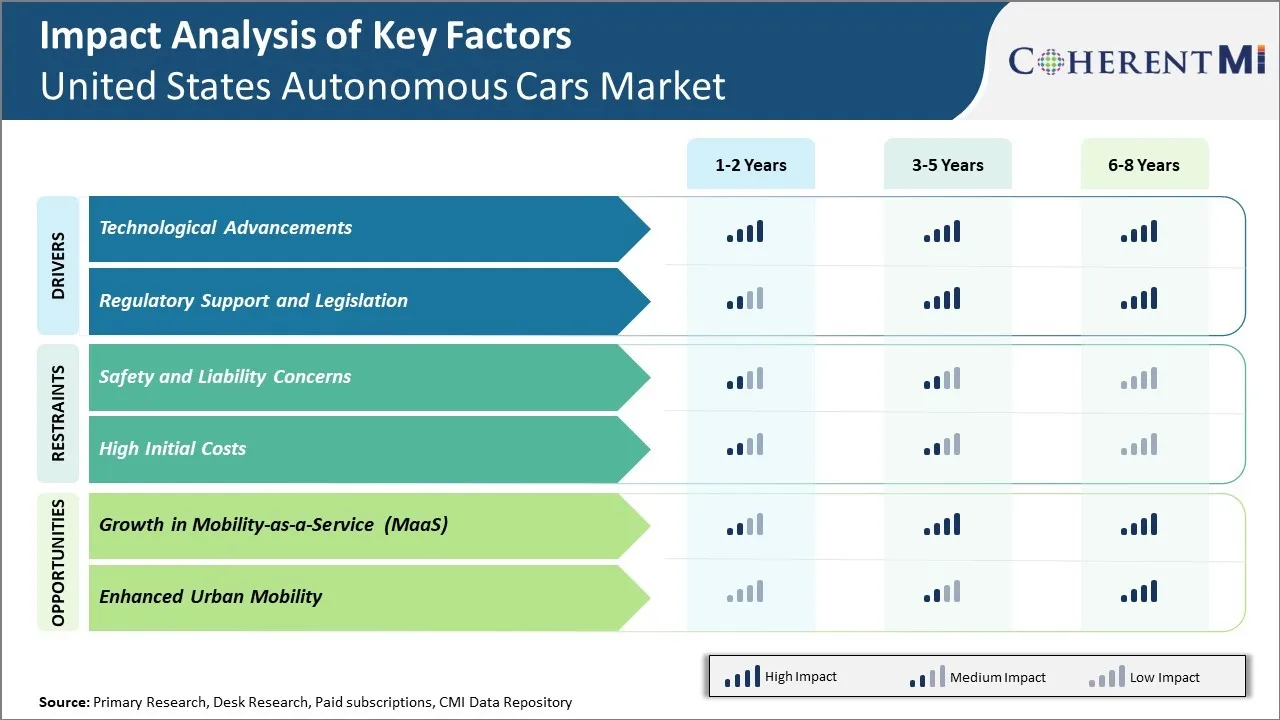United States Autonomous Cars Market Trends
Market Driver – Technological Advancements
Technological advancements are significantly driving the growth of autonomous cars market in the United States. Developments in technologies like artificial intelligence, machine learning, sensors and mobile connectivity are enabling self-driving capabilities in vehicles. Cars are increasingly being equipped with advanced driver assistance systems like adaptive cruise control, blind spot monitoring and automatic emergency braking. Major automakers like Tesla, GM and Ford have also introduced vehicles with SAE Level 2 and Level 3 autonomous capabilities for highway driving and parking.
The advancements are attracting huge investments in research and development from automakers as well as technology companies. For example, Tesla invested over $2 billion in R&D in 2021 alone to develop fully autonomous driving systems through its custom AI chip and neural networks. Startups like Cruise, Waymo and Argo AI are also testing autonomous vehicles without drivers on public roads in several US states. They have collected massive amounts of real-world driving data to continuously improve the capabilities of their self-driving systems. The testing is helping identify and address remaining challenges to achieve true driverless capabilities without any human intervention.
Market Driver – Regulatory Support and Legislation
Regulatory support and legislation are major drivers for the growth of autonomous cars market in the United States. With advances in autonomous driving technology, several states have proactively introduced new legislation to test and operate driverless vehicles on public roads. For example, California was the first U.S. state to introduce autonomous vehicle regulations in 2014. It has permitted companies like Waymo, Cruise and Moton to test fully driverless cars without backup drivers. Several other states like Texas, Florida, Pennsylvania, Michigan, Washington and Nevada have also passed new laws that removed previous legal barriers and allowed on-road testing and operation of autonomous vehicles without human drivers under certain conditions.
The federal government also supports research and development of autonomous cars. In 2016, the U.S. Department of Transportation released new federal guidance and 37 safety design elements for autonomous vehicles. This established a framework for testing and deployment of autonomous technology. The DOT has also invested over $100 million in mobility on demand sandbox pilot projects across several U.S. cities to test autonomous shuttles. The Bipartisan Infrastructure Deal passed by Congress in 2021 includes $7.5 billion to support electric vehicle infrastructure and $7.5 billion for a new program to fund alternative fuel corridors across the nation.

Market Challenge – Safety and Liability Concerns
Safety and liability concerns continue to significantly restrain the growth of the autonomous vehicle market in the United States. There are major uncertainties around how to address the legal and policy issues that emerge when taking human drivers out of the driving task. Without clear federal standards and regulations on the testing and deployment of self-driving cars, consumers remain hesitant to adopt this new technology due to uncertainty over how safety will be ensured.
Additionally, it is unclear who will be at fault in the event of an accident involving an autonomous vehicle - the passenger, the manufacturer, or the software developer. Automakers and technology companies are concerned about taking full liability, especially in the early stages of the technology before the root causes of potential issues are fully understood. The lack of consensus on issues around legal liability and insurance has discouraged significant investment in research and development by automakers. Without agreement on regulatory frameworks to address these challenges, widespread commercialization of autonomous vehicles faces delays.
Market Opportunity – Growth in Mobility-as-a-Service
Growth in Mobility-as-a-Service could offer great opportunities in the United States autonomous cars market. With Mobility-as-a-Service (MaaS), individuals can purchase access to different means of transport via an application on their smartphones. Users will have the freedom to choose from a variety of autonomous vehicle options for their transportation needs, whether it's using self-driving taxis, buses or renting a vehicle, all through a single platform. This will help reduce dependency on personal vehicles and promote shared and sustainable transportation solutions.
MaaS is expected to revolutionize personal transportation by shifting the focus from vehicle ownership to mobility usage. This change will encourage more people to use autonomous vehicles as their preferred mode of transport. With MaaS platforms integrating various transport options, users will have a convenient "one-stop-shop" to fulfill their diverse mobility requirements. It will make transportation more affordable, accessible and economical compared to maintaining a personal vehicle. Issues like parking spaces and traffic congestion caused by privately owned vehicles are also expected to decrease with higher adoption of MaaS and autonomous fleets.
Data from the U.S. Department of Transportation shows that transportation is currently the second largest household expense after housing.